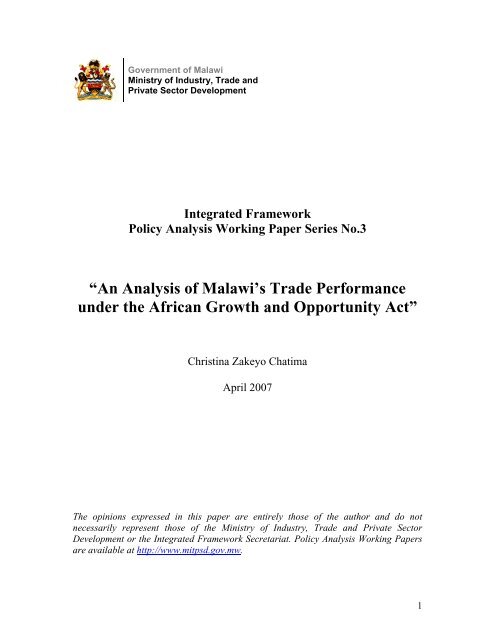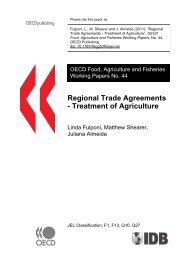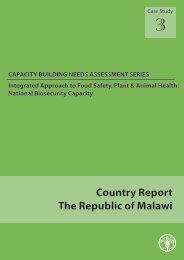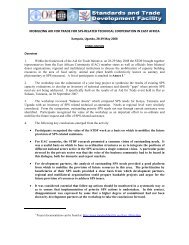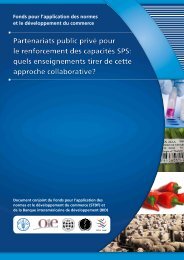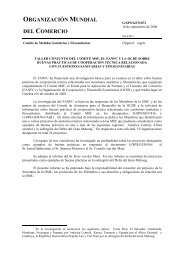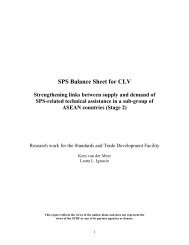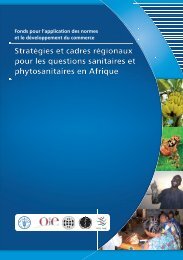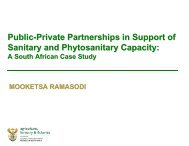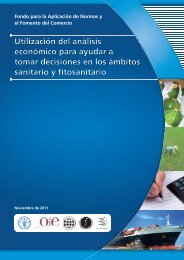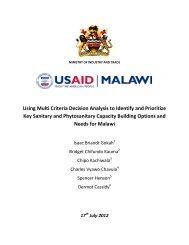An Analysis of Malawi's Trade Performance under the African ...
An Analysis of Malawi's Trade Performance under the African ...
An Analysis of Malawi's Trade Performance under the African ...
Create successful ePaper yourself
Turn your PDF publications into a flip-book with our unique Google optimized e-Paper software.
Government <strong>of</strong> Malawi<br />
Ministry <strong>of</strong> Industry, <strong>Trade</strong> and<br />
Private Sector Development<br />
Integrated Framework<br />
Policy <strong>An</strong>alysis Working Paper Series No.3<br />
“<strong>An</strong> <strong>An</strong>alysis <strong>of</strong> Malawi’s <strong>Trade</strong> <strong>Performance</strong><br />
<strong>under</strong> <strong>the</strong> <strong>African</strong> Growth and Opportunity Act”<br />
Christina Zakeyo Chatima<br />
April 2007<br />
The opinions expressed in this paper are entirely those <strong>of</strong> <strong>the</strong> author and do not<br />
necessarily represent those <strong>of</strong> <strong>the</strong> Ministry <strong>of</strong> Industry, <strong>Trade</strong> and Private Sector<br />
Development or <strong>the</strong> Integrated Framework Secretariat. Policy <strong>An</strong>alysis Working Papers<br />
are available at http://www.mitpsd.gov.mw.<br />
1
INTEGRATED FRAMEWORK (IF ) PAPER WORKING SERIES:<br />
AN ANALYSIS OF MALAWI’S TRADE PERFORMANCE UNDER THE AFRICAN<br />
GROWTH AND OPPORTUNITIES ACT (AGOA)<br />
By<br />
Christina Zakeyo Chatima<br />
TABLE OF CONTENTS<br />
I. Introduction and Executive Summary 2<br />
II. Overview <strong>of</strong> Malawi’s <strong>Trade</strong> with <strong>the</strong> World 6<br />
III. <strong>Performance</strong> <strong>of</strong> Malawi’s <strong>Trade</strong> with <strong>the</strong> USA <strong>under</strong><br />
<strong>the</strong> AGOA 10<br />
IV. Major Challenges in implementing <strong>the</strong> AGOA initiative 15<br />
V. Possible Solutions to overcome <strong>the</strong> Challenges 18<br />
VI. Recommendations 22<br />
VII. Conclusions 24<br />
Page<br />
2
Chapter 1: INTRODUCTION AND EXECUTIVE SUMMARY<br />
The <strong>African</strong> Growth and Opportunity was enacted on May 18, 2000 as part <strong>of</strong> <strong>the</strong> <strong>Trade</strong><br />
and Development Act <strong>of</strong> <strong>the</strong> United States <strong>of</strong> America. The Act extends to <strong>African</strong><br />
beneficiary countries <strong>the</strong> most liberal access to <strong>the</strong> United States market available to<br />
any countries except those with which <strong>the</strong> United States has Free <strong>Trade</strong> Agreement.<br />
The Act has three salient features: first, <strong>the</strong> sense in which it benefits <strong>the</strong> <strong>African</strong><br />
countries; second, its positive effect on American business; third, <strong>the</strong> conditions that<br />
countries have to fulfill in order to enjoy <strong>the</strong> benefits <strong>of</strong> <strong>the</strong> Act.<br />
Regarding <strong>the</strong> sense in which <strong>the</strong> Act benefits <strong>African</strong> countries, <strong>the</strong> Act reinforces<br />
<strong>African</strong> reform efforts, provides improved access to US credit and technical expertise,<br />
and establishes a high level dialogue on trade and investment in <strong>the</strong> form <strong>of</strong> a US-<br />
Africa <strong>Trade</strong> and Economic cooperation Forum. Concerning <strong>the</strong> way in which <strong>the</strong> Act<br />
benefits US firms, AGOA contributes to better market access opportunities and better<br />
commercial partners in Africa and new opportunities in privatization <strong>of</strong> <strong>African</strong> state<br />
owned enterprises and infrastructure projects.<br />
Turning to <strong>the</strong> conditions placed on participation by <strong>African</strong> countries, it is worth<br />
noting that in <strong>the</strong> Act, it is stipulated that <strong>the</strong> President <strong>of</strong> <strong>the</strong> US designates a Sub-<br />
Saharan country as eligible to receive benefits <strong>of</strong> <strong>the</strong> Act if it makes progress in such<br />
areas as : establishment <strong>of</strong> market based economies, development <strong>of</strong> political<br />
pluralism and <strong>the</strong> rule <strong>of</strong> law, elimination to barriers to US trade and investment,<br />
protection <strong>of</strong> intellectual property rights, efforts to combat corruption, policies to<br />
reduce poverty, increased availability <strong>of</strong> health care and educational opportunities,<br />
protection <strong>of</strong> human rights and worker rights and elimination <strong>of</strong> certain practices <strong>of</strong><br />
child labor.( AGOA implementation guide -2000)<br />
3
In 2006, Thirty Seven (37) Sub-Saharan <strong>African</strong> countries 1 are benefiting from <strong>the</strong> Act.<br />
AGOA amends <strong>the</strong> United States Generalized System <strong>of</strong> Preferences (GSP) statute with<br />
respect to AGOA eligible beneficiaries by extending duty free treatment until 20 15<br />
and expanding GSP product coverage by more than 1,800 additional tariff lines. As a<br />
result <strong>of</strong> <strong>the</strong> AGOA, substantially all imports from Sub-Saharan Africa are eligible to<br />
enter <strong>the</strong> United States duty free.<br />
AGOA requires that President determine annually whe<strong>the</strong>r sub-Saharan <strong>African</strong><br />
countries are , or remain , eligible for benefits based on <strong>the</strong>ir progress in meeting <strong>the</strong><br />
eligibility criteria set out in <strong>the</strong> Act. Malawi became an eligible country after passing<br />
through <strong>the</strong> eligibility criteria set forth.<br />
It is also worth noting that <strong>the</strong> AGOA had a limited time <strong>of</strong> up to 2008 but after several<br />
consultations with <strong>the</strong> <strong>African</strong> Governments and some lobbies in <strong>the</strong> USA, amendments<br />
were done to <strong>the</strong> original act to improve <strong>the</strong> initiative. After <strong>the</strong> different<br />
improvements to <strong>the</strong> original Act, and AGOA II was passed. Some <strong>of</strong> <strong>the</strong> amendments<br />
that were done to <strong>the</strong> original Act included:<br />
• extending <strong>the</strong> third country sourcing <strong>of</strong> fabric by LDCs from 2004 to 2007;<br />
• designation <strong>of</strong> o<strong>the</strong>r non LDC countries to benefit from <strong>the</strong> third country<br />
sourcing provision etc.<br />
Malawi became an AGOA eligible country in 2000 and it qualified as a textile and<br />
apparel beneficiary country on 17 th August, 2001, after introducing an effective visa<br />
system to ensure compliance with <strong>the</strong> requirements <strong>of</strong> AGOA for exportation <strong>of</strong> apparel<br />
and textile products to US on a duty and quota-free basis.<br />
1 The 37 AGOA beneficiary countries are <strong>An</strong>gola, Benin, Botswana, Burkina Faso, Burundi, Cameroon,<br />
Cape Verde, Chad, Republic <strong>of</strong> Congo, Democratic Republic <strong>of</strong> Congo, Djibouti, Ethiopia, Gabon, The<br />
Gambia, Ghana, Guinea, Guinea –Bissau, Kenya, Lesotho, Madagascar, Malawi, Mali, Mauritius,<br />
Mozambique, Namibia, Niger, Rwanda, Sao Tome and Principe, Senegal, Seychelles, Sierra Leone, South<br />
Africa, Swaziland, Tanzania, Uganda and Zambia. On January 1, 2006 Burundi was added to <strong>the</strong> list <strong>of</strong><br />
eligible countries, and Mauritania was removed from <strong>the</strong> list.<br />
4
Malawi is amongst <strong>the</strong> Least Developed Countries benefiting from <strong>the</strong> third-countryapparel<br />
provision that allows duty and quota-free access for apparel made from fabrics<br />
imported from anywhere in <strong>the</strong> world. As <strong>of</strong> April, 2006, 25 countries were eligible to<br />
receive AGOA apparel benefits 2 . Fourteen <strong>of</strong> <strong>the</strong>se countries 3 also qualified for AGOA’S<br />
provisions for hand-loomed and hand made articles (known as Category 9).<br />
This research paper aims at analyzing Malawi’s trade performance <strong>under</strong> <strong>the</strong> AGOA<br />
since Malawi’s designation in 2000 and recommends ways on how to fully utilize <strong>the</strong><br />
benefits <strong>under</strong> <strong>the</strong> Act up to 2015. It has <strong>the</strong> following objectives:<br />
• Assess Malawi’s performance in utilizing <strong>the</strong> AGOA initiative ;<br />
• Identify challenges from implementing <strong>the</strong> initiative; and<br />
• Propose solutions and make recommendations on how to take full advantage <strong>of</strong><br />
<strong>the</strong> AGOA initiative<br />
In terms <strong>of</strong> methodology, <strong>the</strong> paper aims at addressing <strong>the</strong> following concerns:<br />
First to provide information on AGOA using literature review <strong>of</strong> primary and secondary<br />
sources. The facts were obtained from such sources as documented policies by <strong>the</strong><br />
United States Department <strong>of</strong> Commerce, and annual comprehensive reports on US trade<br />
and Investment Policy Towards Sub-Saharan Africa and Implementation <strong>of</strong> <strong>the</strong> <strong>African</strong><br />
Growth and Opportunity Act. O<strong>the</strong>r sources were <strong>the</strong> interviews with Key AGOA<br />
implementing agencies in Malawi, business persons and Government <strong>of</strong>ficials.<br />
In addition, o<strong>the</strong>r facts were unear<strong>the</strong>d from newspapers and magazine findings as well<br />
as from research papers by individuals and from several websites.<br />
2 The 25 countries eligible to receive AGOA apparel benefits are Benin, Botswana, Cameroon, Cape<br />
Verde, Chad, Ethiopia, Ghana, Kenya, Lesotho, Madagascar, Malawi, Mali, Mauritius, Mozambique,<br />
Namibia, Niger, Nigeria, Rwanda, Senegal, Sierra Leone, South Africa, Swaziland, Tanzania, Uganda and<br />
Zambia.<br />
3 The fourteen countries are : Kenya, Lesotho, Botswana, Malawi, Swaziland, Namibia, Zambia, Ghana,<br />
Mozambique, Tanzania, Senegal, Ethiopia, Nigeria and Sierra Leone.<br />
5
In light <strong>of</strong> <strong>the</strong> above, <strong>the</strong> first part <strong>of</strong> <strong>the</strong> paper will make an analysis <strong>of</strong> Malawi’s trade<br />
performance with <strong>the</strong> World. This has been done to give an overview <strong>of</strong> Malawi’s trading<br />
partners and <strong>the</strong> products Malawi trades in as well as how Malawi is performing in <strong>the</strong><br />
international arena.<br />
The second part explains in detail <strong>the</strong> pattern <strong>of</strong> Malawi’s trade with <strong>the</strong> United States,<br />
before and after Malawi became an AGOA beneficiary country. The main objective is to<br />
establish if <strong>the</strong> AGOA has indeed brought any changes in <strong>the</strong> pattern <strong>of</strong> trade with <strong>the</strong><br />
United States <strong>of</strong> America. Data will be provided and analyzed to gain <strong>the</strong> required results.<br />
The third part delves into analyzing <strong>the</strong> major challenges facing Malawi in <strong>the</strong><br />
implementation <strong>of</strong> <strong>the</strong> AGOA initiative since Malawi became a beneficiary country. This<br />
part shows <strong>the</strong> different actions that government and o<strong>the</strong>r stakeholders have continued to<br />
take to make AGOA a success story in Malawi.<br />
The fourth part describes and provided <strong>the</strong> possible solutions to overcome <strong>the</strong><br />
challenges.<br />
In <strong>the</strong> conclusions, <strong>the</strong> paper makes recommendations to ensure <strong>the</strong> successful<br />
implementation <strong>of</strong> <strong>the</strong> AGOA programme in Malawi <strong>of</strong> course taking into considerations<br />
<strong>the</strong> views <strong>of</strong> all <strong>the</strong> concerned stakeholders with <strong>the</strong> aim <strong>of</strong> developing trade between<br />
Malawi and <strong>the</strong> United States <strong>of</strong> America through <strong>the</strong> AGOA.<br />
Chapter 2: Overview <strong>of</strong> Malawi’s <strong>Trade</strong> with <strong>the</strong> World<br />
2(a) . <strong>Trade</strong> Agreements and Arrangements<br />
Malawi’s trade policy is aligned to <strong>the</strong> World <strong>Trade</strong> Organization (WTO) Agreement to<br />
which Malawi is a signatory member, since 1995 [previously having been a member <strong>of</strong><br />
General Agreement on Tariffs and <strong>Trade</strong> (GATT), since <strong>the</strong> 1960s].<br />
6
Malawi is signatory to <strong>the</strong> Africa, Caribbean and Pacific (ACP) – European Union (EU)<br />
Partnership Agreement (commonly known as “Cotonou Agreement”). Malawi is a<br />
member <strong>of</strong> <strong>the</strong> commodity agreements such as International Sugar Organization (ISO)<br />
and is also signatory to <strong>the</strong> International C<strong>of</strong>fee and Tea Agreements.<br />
At bilateral level, Malawi maintains asymmetrical and symmetrical trade<br />
agreements with <strong>the</strong> Republic <strong>of</strong> South Africa, Mozambique, and <strong>the</strong> Republic <strong>of</strong><br />
Zimbabwe, and a Customs Agreement with <strong>the</strong> Republic <strong>of</strong> Botswana. Malawi is<br />
in <strong>the</strong> process <strong>of</strong> negotiating new bilateral trade agreements with Tanzania and Namibia.<br />
At regional level, Malawi is signatory to <strong>the</strong> Sou<strong>the</strong>rn <strong>African</strong> Development Community<br />
(SADC) <strong>Trade</strong> Protocol and <strong>the</strong> Common Market for Eastern and Sou<strong>the</strong>rn Africa<br />
(COMESA) Treaty. Malawi joined <strong>the</strong> COMESA Free <strong>Trade</strong> Area (FTA) on 31 st<br />
October 2000, and it is expected that a Customs Union will be established. In <strong>the</strong> case <strong>of</strong><br />
<strong>the</strong> SADC <strong>Trade</strong> Protocol, member states, including Malawi, are implementing tariff<br />
reductions and eliminating non-tariff barriers with a view <strong>of</strong> establishing an FTA in 2008.<br />
Malawi trades with <strong>the</strong> EU on preferential terms <strong>under</strong> <strong>the</strong> Cotonou Agreement and <strong>the</strong><br />
Everything But Arms (EBA) Initiative. Currently, Malawi, toge<strong>the</strong>r with <strong>the</strong> o<strong>the</strong>r ACP<br />
States, are negotiating new trade arrangements with <strong>the</strong> EU known as Economic<br />
Partnership Agreements (EPAs). The EPAs will provide for reciprocal trade preferences<br />
between individual ACP States and <strong>the</strong> EU. Malawi is participating in <strong>the</strong> EPA<br />
negotiations, toge<strong>the</strong>r with 15 o<strong>the</strong>r countries in an Eastern and Sou<strong>the</strong>rn Africa (ESA)<br />
configuration. It is expected that <strong>the</strong> EPAs will enter into force on 1 st January 2008.<br />
The Malawi exports are also given duty and quota-free treatment in Canadian market<br />
<strong>under</strong> <strong>the</strong> Canadian Government and Least Developed Countries’ (LDC’) Initiative. The<br />
initiative aims at fighting poverty through provision <strong>of</strong> preferential access to <strong>the</strong><br />
Canadian market for products from <strong>the</strong> LDCs, including Malawi. The initiative provides<br />
duty-free and quota free access to Canada’s imports, with <strong>the</strong> exception <strong>of</strong> dairy, poultry<br />
and eggs. The Government <strong>of</strong> <strong>the</strong> Republic <strong>of</strong> Malawi and <strong>the</strong> Government <strong>of</strong> Canada on<br />
7
12 th February 2004, signed a Memorandum <strong>of</strong> Understanding on <strong>the</strong> Least Developed<br />
Countries (LDCs) Market Access Initiative. Malawi, <strong>the</strong>refore, qualified to receive duty<br />
and quota free access to Canadian markets <strong>under</strong> this agreement.<br />
Since November 2001, Malawi has been participating in WTO negotiations on<br />
Agriculture, Non-Agricultural Market Access (NAMA), development issues, trade<br />
facilitation and <strong>Trade</strong> in Services, <strong>under</strong> <strong>the</strong> Doha Development Agenda.<br />
2(b). <strong>Trade</strong> with major trading partners<br />
Malawi’s major trading partners include <strong>the</strong> European Union (EU), <strong>the</strong> United States <strong>of</strong><br />
America (US), and <strong>the</strong> SADC and COMESA regions. Approximately 40% <strong>of</strong> Malawi’s<br />
exports go to <strong>the</strong> EU, ano<strong>the</strong>r 20% goes to <strong>the</strong> SADC region (mainly South Africa), a<br />
fur<strong>the</strong>r 12% goes to <strong>the</strong> US, and 5% goes to non-SADC COMESA countries.<br />
In terms <strong>of</strong> imports, approximately 45% <strong>of</strong> Malawi’s imports come from <strong>the</strong> SADC<br />
region (mainly South Africa), ano<strong>the</strong>r 25% from <strong>the</strong> EU, 2% from <strong>the</strong> US and 1% from<br />
non-SADC COMESA countries.<br />
Figure 1: Malawi <strong>Trade</strong> with <strong>the</strong> World in US$<br />
Figure 1: Malawi <strong>Trade</strong> with <strong>the</strong> World in US$<br />
Source: Ministry <strong>of</strong> Industry, <strong>Trade</strong> and Private Sector Development statistics <strong>of</strong>fice<br />
8
<strong>An</strong> analysis <strong>of</strong> <strong>the</strong> above table shows that Malawi has consistently experienced trade<br />
deficit from 1994 to 2005:<br />
Malawi’s Export Sector<br />
The agricultural sector accounts for 43% <strong>of</strong> GDP and 90% <strong>of</strong> all export earnings.<br />
Malawi’s export sector is dominated by primary commodities, which include<br />
tobacco, sugar, tea and c<strong>of</strong>fee. A renewed emphasis has been placed on <strong>the</strong> cotton<br />
industry as a growth sector. Of <strong>the</strong> non-traditional exports, textiles and clothing is <strong>the</strong><br />
major item that has, in recent years shown strong annual growth. Exports <strong>of</strong> apparel or<br />
clothing have found markets in <strong>the</strong> US <strong>under</strong> <strong>the</strong> AGOA and <strong>the</strong> SADC <strong>under</strong> <strong>the</strong> SADC<br />
<strong>Trade</strong> Protocol.<br />
The main tobacco markets are <strong>the</strong> EU (Germany, Belgium, Ne<strong>the</strong>rlands, Spain, and<br />
France), Japan, USA and Egypt. The main markets for sugar are <strong>the</strong> EU (UK, France,<br />
Ne<strong>the</strong>rlands, Portugal), USA, South Africa, Kenya, Mozambique and Tanzania. The main<br />
markets for tea are <strong>the</strong> EU (UK, Ne<strong>the</strong>rlands), USA, Kenya, Egypt and Botswana. The<br />
main markets for c<strong>of</strong>fee are <strong>the</strong> EU (UK, Germany, Belgium, and France), USA and<br />
South Africa. The main markets for cotton are <strong>the</strong> EU (UK), Zimbabwe and Zambia. The<br />
interest in cotton is not merely as an export crop but as a raw material in <strong>the</strong> growing<br />
textile and garment industry in Malawi.<br />
The apparel provisions <strong>of</strong> AGOA have led to significant growth in <strong>the</strong> apparel exports<br />
from Malawi as can be seen from Table 2 below.<br />
9
Malawi’s major exports, to each <strong>of</strong> its major trading partners, are summarized below:<br />
Table 2: Major Exports to Major Trading Partners<br />
Trading Partner<br />
EU USA SADC COMESA JAPAN CANADA<br />
Tobacco Tobacco Tobacco Tobacco Tobacco Tobacco<br />
Tea Tea Farm Tea Tea Tea<br />
vegetables<br />
Sugar Sugar Rubber Sugar Lea<strong>the</strong>r C<strong>of</strong>fee<br />
C<strong>of</strong>fee Apparel<br />
and<br />
Clothing<br />
products<br />
Apparel<br />
and<br />
Clothing<br />
products<br />
C<strong>of</strong>fee C<strong>of</strong>fee Apparel<br />
and<br />
Clothing<br />
products<br />
Source: MOITPSD Statistics Office<br />
Import Sector<br />
Malawi’s major imports, from each <strong>of</strong> its major trading partners, are as below:<br />
Table 3: Major Imports from Major Trading Partners<br />
Trading Partner<br />
EU USA SADC COMESA JAPAN CANADA<br />
Mineral fuels Maize Mineral fuels Products <strong>of</strong> iron Opticals Textiles and<br />
and steel<br />
clothing<br />
Nuclear reactors Textiles and Vehicles and Vehicles Vehicles, Nuclear reactors<br />
clothing industrial spares<br />
parts and<br />
accessories<br />
and industrial<br />
10
spares<br />
Electrical Electrical Electrical Pharmaceutical Electrical Cereals<br />
machinery and machinery and machinery and Products machinery<br />
equipment equipment equipment<br />
and<br />
equipment<br />
Vehicles Chemicals Chemicals Cereals Photographic Electrical<br />
parts machinery and<br />
equipment<br />
Pharmaceutical<br />
Products<br />
Pharmaceutical<br />
Products<br />
Pharmaceutical<br />
Products<br />
Fertilizers Printed books Pharmaceutical<br />
Products<br />
CHAPTER 3: PERFORMANCE OF MALAWI’S TRADE WITH THE<br />
USA UNDER THE AGOA<br />
This chapter tries to evaluate <strong>the</strong> performance <strong>of</strong> trade between Malawi before and after<br />
<strong>the</strong> enactment <strong>of</strong> <strong>the</strong> AGOA programme.<br />
Essentially all products <strong>of</strong> AGOA beneficiary countries including Malawi may enter <strong>the</strong><br />
United States duty free, ei<strong>the</strong>r <strong>under</strong> AGOA, GSP, or <strong>under</strong> a category for which <strong>the</strong><br />
United States maintains a zero normal trade relations rate <strong>of</strong> duty. In <strong>the</strong> case <strong>of</strong> Malawi,<br />
exports to <strong>the</strong> United States enter both <strong>under</strong> <strong>the</strong> AGOA and Generalized System <strong>of</strong><br />
Preferences. Most <strong>of</strong> <strong>the</strong> products being exported <strong>under</strong> <strong>the</strong> GSP include, tea, c<strong>of</strong>fee,<br />
sugar , tobacco etc and it is in <strong>the</strong>se few cases where US tariff rate quotas exist.<br />
Malawi’s exports to <strong>the</strong> United States consist almost exclusively <strong>of</strong> agricultural products<br />
followed by textiles and apparel. Of <strong>the</strong> apparel exports, all are currently exported to <strong>the</strong><br />
United States <strong>under</strong> <strong>the</strong> AGOA.<br />
But due to <strong>the</strong> concentrated nature <strong>of</strong> goods, exports from Malawi to <strong>the</strong> United States<br />
qualify for duty free benefits <strong>of</strong> <strong>the</strong> AGOA.<br />
11
The agriculture exports include dried fruits and nuts (macadamia nuts) and ano<strong>the</strong>r major<br />
export product is timber (hand crafts). See attached table 4 on trade between <strong>the</strong> two<br />
countries <strong>under</strong> <strong>the</strong> GSP and <strong>the</strong> AGOA.<br />
Malawi’s exports <strong>under</strong> <strong>the</strong> AGOA and its GSP provisions were valued at nearly $66<br />
million in 2005 representing 57% <strong>of</strong> <strong>the</strong> country’s total exports to <strong>the</strong> United States. The<br />
most exciting AGOA related activity in Malawi has been in <strong>the</strong> textile and apparel<br />
sectors.<br />
The table and figures below demonstrate <strong>the</strong> pattern <strong>of</strong> trade between Malawi and USA<br />
before and after <strong>the</strong> AGOA initiative.<br />
Table 4: MALAWI TRADE WITH USA –( 1994-2005)<br />
VALUE US<br />
$ ('000') US$ US$ US$ US$ US$ US$ US$ US$ US$ US$ US$ US$<br />
YEARS 1994 1995 1996 1997 1998 1999 2000 2001 2002 2003 2004 2005<br />
TOTAL<br />
DOMESTIC<br />
EXPORTS<br />
TO USA 840 64,916 58,620 52,091 47,937 58,422 35,306 67,382 53,757 52,565 54,494 54,329<br />
TOTAL<br />
IMPORTS<br />
TO USA 18,191 13,530 13,483 18,726 6,195 13,332 6,936 21,212 14,465 21,561 25,164 29,099<br />
TRADE<br />
BALANCE<br />
-<br />
17,351 51,385 45,138 33,365 41,742 45,090 28,370 46,170 39,292 31,004 29,330 25,230<br />
Figure 2: <strong>Trade</strong> between Malawi and <strong>the</strong> United States <strong>of</strong> America<br />
12
MALAWI TRADE WITH USA 1994-2005<br />
80,000<br />
70,000<br />
60,000<br />
50,000<br />
40,000<br />
30,000<br />
20,000<br />
10,000<br />
TOTAL DOMESTIC EXPORTS TO USA<br />
TOTAL IMPORTS TO USA<br />
TRADE BALANCE<br />
0<br />
-10,000<br />
1994 1995 1996 1997 1998 1999 2000 2001 2002 2003 2004 2005<br />
-20,000<br />
-30,000<br />
YEARS<br />
Source: Ministry <strong>of</strong> Industry, <strong>Trade</strong> and Private Sector Development Statistics<br />
Office.<br />
You will notice from <strong>the</strong> graph and <strong>the</strong> table above that trade between <strong>the</strong> two countries<br />
is skewed towards net exports from Malawi. The trade balance fur<strong>the</strong>r increased from<br />
2001 after Malawi had just qualified as a beneficiary country. But <strong>the</strong> trade balance<br />
fur<strong>the</strong>r dropped after 2004 which could be due to <strong>the</strong> end <strong>of</strong> <strong>the</strong> multifibre agreement<br />
<strong>under</strong> <strong>the</strong> WTO that led to some <strong>of</strong> <strong>the</strong> major companies reducing exports to <strong>the</strong> USA and<br />
one <strong>of</strong> <strong>the</strong>m closing. (Haps Investments Ltd based in Lilongwe). The table below also<br />
provides fur<strong>the</strong>r information on how <strong>the</strong> textile sector has performed since inception <strong>of</strong><br />
AGOA in Malawi. It is clear from <strong>the</strong> table that <strong>the</strong> end <strong>of</strong> <strong>the</strong> Multifibe Agreement had<br />
an impact on <strong>the</strong> textile exports to <strong>the</strong> US. From 2001 to 2004 exports had been<br />
increasing but later on dropped in 2005. After 2005 <strong>the</strong>re has been a significant drop in<br />
exports to <strong>the</strong> USA and <strong>the</strong> drop in exports has taken place during <strong>the</strong> time <strong>the</strong> WTO<br />
Agreement on Textiles and <strong>Trade</strong> was integrated into <strong>the</strong> multilateral trading system<br />
with quotas being removed in textile trade.<br />
It is important to note that before <strong>the</strong> end <strong>of</strong> <strong>the</strong> Multifibre Agreement, major textile and<br />
apparel producers in <strong>the</strong> world such as China and o<strong>the</strong>r producers were constrained in<br />
exporting to <strong>the</strong> US but after <strong>the</strong> expiry <strong>of</strong> <strong>the</strong> MFA, <strong>the</strong> restrictions were uplifted. This<br />
drop in export trade by Malawian exporters during this time could be a result <strong>of</strong> <strong>the</strong> end<br />
<strong>of</strong> <strong>the</strong> Multifibre Agreement.<br />
13
Following <strong>the</strong> drop <strong>of</strong> exports to <strong>the</strong> US, most <strong>of</strong> <strong>the</strong> textile companies switched to <strong>the</strong>ir<br />
old South <strong>African</strong> market. This was because <strong>the</strong>y could not compete in <strong>the</strong> US market<br />
and one <strong>of</strong> <strong>the</strong> AGOA major export companies Haps Investments Ltd that used to<br />
employ more than 2,000 workers closed and reallocated to China.<br />
According to <strong>the</strong> US Comprehensive report on <strong>Trade</strong> and Investment Policy towards<br />
Africa and <strong>the</strong> implementation <strong>of</strong> <strong>the</strong> AGOA , <strong>the</strong> end <strong>of</strong> <strong>the</strong> MFA hurt Africa more<br />
significantly than any o<strong>the</strong>r region in <strong>the</strong> world resulting in 39%decline in exports.<br />
Table 2: Malawi Apparel Exports <strong>of</strong> AGOA to <strong>the</strong> US<br />
2001 2002 2003 2004 2005 2006 GRAND<br />
TOTAL<br />
Total<br />
Total<br />
Total<br />
Total<br />
Total<br />
Total<br />
Total<br />
(US$ ‘000)<br />
(US$ ‘000)<br />
(US$ ‘000)<br />
(US$ ‘000)<br />
(US$’000)<br />
(US$’000)<br />
(US$’000)<br />
4,819,281 12,195,722 24,176,987 27,351,607 20,216,881 6,726,167 95,488,645<br />
Source: Malawi Revenue Authority<br />
At <strong>the</strong> mean time, seven registered companies 4 export <strong>under</strong> <strong>the</strong> AGOA in Malawi. The<br />
companies are registered through a process where it applies to <strong>the</strong> Malawi Revenue<br />
Authority for registration. The verification team conducts <strong>the</strong> factory visits and approves<br />
<strong>the</strong> company if <strong>the</strong> company meets certain conditions relating to safety, standards, labour<br />
issues etc.<br />
4 Crown Fashions Ltd, Haps investments Ltd, Chirimba Garments Ltd, Knit wear<br />
industries Ltd, Crossbow Clothing Ltd, Giant Clothing Ltd, Win Win Garments Ltd and<br />
Mapeto David White Head and Sons Ltd.<br />
14
The verification exercise only applies to companies in <strong>the</strong> textile and apparel sector.<br />
Most <strong>of</strong> <strong>the</strong>se companies started exporting soon after <strong>the</strong> inclusion <strong>of</strong> Malawi as one <strong>of</strong><br />
<strong>the</strong> textile and apparel beneficiary country in 2001.<br />
In terms <strong>of</strong> exports <strong>of</strong> dried fruits and nuts, Macadamia nuts are <strong>the</strong> only nuts being<br />
exported to <strong>the</strong> United States. The major exporting company is Sable Manufacturing<br />
Company Ltd. As regards exports <strong>of</strong> wood, <strong>the</strong> Malawi Revenue Authority indicated that<br />
handcrafts made <strong>of</strong> wood have been exported to <strong>the</strong> USA not in large quantities. These<br />
are mainly gifts and souveniours.<br />
3 (a) Initiatives to implement AGOA Programme in Malawi<br />
To assist small and medium enterprises to take advantage <strong>of</strong> <strong>the</strong> initiative, <strong>the</strong> Ministry <strong>of</strong><br />
Industry, <strong>Trade</strong> and Private Sector Development <strong>under</strong>took to use funds that were<br />
provided for by Ministry <strong>of</strong> Finance <strong>under</strong> <strong>the</strong> HIPC Initiative to boost <strong>the</strong><br />
implementation <strong>of</strong> <strong>the</strong> AGOA in Malawi. The funds were used for <strong>the</strong> following<br />
initiatives:<br />
• Construction <strong>of</strong> factor shells in Kanengo Lilongwe. The motive behind <strong>the</strong><br />
construction <strong>of</strong> <strong>the</strong>se shells was for prospective investors who would be interested<br />
to venture into textile and apparel business and o<strong>the</strong>r AGOA related activity. This<br />
was a major activity that needed enough funds to accomplish <strong>the</strong> intended<br />
purpose. But due to lack <strong>of</strong> financial resources by Government, <strong>the</strong> project could<br />
not proceed . Due to <strong>the</strong> importance <strong>of</strong> <strong>the</strong>se to prospective investors,<br />
Government could still set aside some funds for <strong>the</strong> completition <strong>of</strong> <strong>the</strong><br />
incomplete factory shells. Seeking financial support from donors could be<br />
ano<strong>the</strong>r option.<br />
• Sub-contracting <strong>of</strong> Small and Medium Enterprises to large textile apparel<br />
manufacturing companies. The Ministry and o<strong>the</strong>r support institutions like Small<br />
Enterprise Development <strong>of</strong> Malawi visited several AGOA apparel exporting<br />
companies to seek <strong>the</strong>ir opinion <strong>of</strong> allowing SMEs to subcontract. But due to lack<br />
15
<strong>of</strong> skills and capacity by <strong>the</strong> envisaged SMEs <strong>the</strong> programmes did not succeed.<br />
Most companies were reluctant to enter into such arrangements due to <strong>the</strong> nature<br />
<strong>of</strong> <strong>the</strong> US market which was sophisticated and that <strong>the</strong>re was need for such SMEs<br />
to have proper training.<br />
• Purchase <strong>of</strong> machines for <strong>the</strong> Blantyre cooperative. As one way to assist SMEs to<br />
take advantage <strong>of</strong> <strong>the</strong> AGOA Initiative, Government through <strong>the</strong> Ministry <strong>of</strong><br />
Industry, <strong>Trade</strong> and Private Sector Development used <strong>the</strong> HIPC resources by<br />
supporting <strong>the</strong> Blantyre Cooperative to purchase sewing machines. The aim<br />
behind this initiative was to empower Malawians economically to take advantage<br />
<strong>of</strong> <strong>the</strong> AGOA Initiative. The programme could not succeed and proceed due to<br />
lack <strong>of</strong> working capital by <strong>the</strong> cooperative . On <strong>the</strong> o<strong>the</strong>r hand, management <strong>of</strong><br />
<strong>the</strong> programme was a problem and <strong>the</strong>re was lack <strong>of</strong> coordination amongst <strong>the</strong><br />
entrepreneurs in <strong>the</strong> cooperative. .The o<strong>the</strong>r problems included lack <strong>of</strong> proper<br />
skills to produce a product that could sell in America,and lack <strong>of</strong> customer<br />
information etc.<br />
It would also be worth noting that in <strong>the</strong> Agriculture sector, USAID has instituted a<br />
programme called Support for Agriculturally –Linked Enterprises (SALES) whose focus<br />
is on <strong>the</strong> production and export <strong>of</strong> cotton, tea, c<strong>of</strong>fee, and macadamia nuts. This<br />
programme also aims at assisting Malawi take advantage <strong>of</strong> <strong>the</strong> AGOA initiative.<br />
3 (b) Potential export products<br />
Some <strong>of</strong> <strong>the</strong> major AGOA agriculture export potential products include processed<br />
paprika, macadamia nuts and ground nuts.<br />
There is also an improving comparative advantage in fresh and dried nuts. The processing<br />
<strong>of</strong> ground nuts and o<strong>the</strong>r nuts into oils also represents a potential downstream export if<br />
crushing capacity can be increased.<br />
16
Fruit juice also represents a potential export because approximately 50% <strong>of</strong> mangoes,<br />
tangerines and o<strong>the</strong>r tropical fruits go waste ever year do to lack <strong>of</strong> manufacturing<br />
processing plants. Development <strong>of</strong> <strong>the</strong> sector requires capital investment. Currently, <strong>the</strong>re<br />
is Mulanje Peak Foods Ltd that has specialized in <strong>the</strong> production <strong>of</strong> canned foods but it is<br />
not clear yet if <strong>the</strong> company has plans to export to <strong>the</strong> US <strong>under</strong> <strong>the</strong> initiative.<br />
Horticulture products such as mushroom, chilies, etc also have export growth potential.<br />
Cut flowers have also been identified as having <strong>the</strong> export potential. Neem medicinal<br />
plant grown in Nsanje District also has <strong>the</strong> export potential.<br />
The Government and industry have also identified increased production and vertical<br />
integration <strong>of</strong> <strong>the</strong> cotton sector apparel production as export growth sectors.<br />
Malawi also has comparative advantage in <strong>the</strong> some apparel and textile sector, too,<br />
though infrastructure improvements and trade capacity building is needed in <strong>the</strong> cotton –<br />
textile garment supply chain.<br />
The o<strong>the</strong>r potential products are <strong>the</strong> hand loomed, handmade and Folklore articles and<br />
ethnic printed Fabrics. The AGOA provided duty free benefits for <strong>the</strong>se articles <strong>under</strong><br />
Category nine. Malawi was nominated after separate consultative process with <strong>the</strong><br />
Committee for <strong>the</strong> Implementation <strong>of</strong> Textile Agreements (CITA).in <strong>the</strong> US Department<br />
<strong>of</strong> Commerce.<br />
Category nine articles are mostly produced by Malawi Council for <strong>the</strong> Handicapped<br />
(MACOHA) and o<strong>the</strong>r women groups <strong>under</strong> <strong>the</strong> Ministry <strong>of</strong> Gender and Community<br />
Services. Since Malawi was designated as an eligible exporter <strong>of</strong> such articles, it has not<br />
exported any due to several factors. The factors range from lack <strong>of</strong> niche market<br />
information, raw materials and lack <strong>of</strong> how to identify producers <strong>of</strong> <strong>the</strong>se products in<br />
Malawi. Therefore, given Malawi’s weak price competitiveness in <strong>the</strong> garments sector,<br />
17
<strong>the</strong> specialization<br />
competition, is vital.<br />
in niche areas such as those for handicrafts, where <strong>the</strong>re is less<br />
CHAPTER 4: MAJOR CHALLENGES IN IMPLEMENTING THE<br />
AGOA INITIATIVE<br />
Since Malawi started participating in <strong>the</strong> AGOA initiative, it has faced and still faces<br />
several challenges which do not only affect it but as well as o<strong>the</strong>r countries in <strong>the</strong> region.<br />
It should also be pointed out here that <strong>the</strong>se constraints are not only tied to <strong>the</strong> AGOA<br />
exports but as well as o<strong>the</strong>r exporting initiatives that Malawi is participating in. Outlined<br />
below are in brief some <strong>of</strong> <strong>the</strong> major challenges Malawi faces. The analysis <strong>of</strong> <strong>the</strong><br />
challenges will be divided into those affecting <strong>the</strong> garments sector and those affecting<br />
<strong>the</strong> o<strong>the</strong>r products.<br />
a. Supply side constraints.<br />
This has been <strong>the</strong> major constraining factor in Malawi from full participation in <strong>the</strong><br />
AGOA programme. The extile and apparel sector is affectd mainly due to <strong>the</strong> fact that<br />
<strong>the</strong> cotton to textiles to garments value chain is fragmented and this makes it too<br />
difficult for Malawi to meet <strong>the</strong> Rules <strong>of</strong> Origin. As indicate above, most <strong>of</strong> <strong>the</strong><br />
AGOA apparel exports are made from <strong>the</strong> third country fabric and Malawi.<br />
The inappropriate production technologies, and inefficient and costly financing for<br />
small and medium enterprises are o<strong>the</strong>r impediments affecting <strong>the</strong> AGOA benefiting<br />
industry in Malawi. Technology and communication obstacles impede export growth <strong>of</strong><br />
<strong>the</strong> potential sectors.<br />
More computers and internet access are needed in order to access market information for<br />
small and medium sized exporters. Erratic supply and inefficiencies in electricity<br />
distribution are common problems that affect several industries particularly <strong>the</strong> apparel<br />
manufacturing industry. Lack <strong>of</strong> cold supply chain and local transport air hub impedes<br />
<strong>the</strong> development <strong>of</strong> horticultural products such as cut flowers. Limited supply capacity<br />
resulting from high input cost and high production costs generally constrain agricultural<br />
exports. Low levels <strong>of</strong> irrigation also lead to low agricultural production levels.<br />
18
. Constraints in manufacturing<br />
The high capital and transport costs and lack <strong>of</strong> adequate infrastructure constrain <strong>the</strong><br />
apparel sector mainly. There is also limited electric capacity for major investments in<br />
spinning and textile mills.These impediments ,as well as slow customs clearance<br />
procedures, reduce <strong>the</strong> competativenes with respect to lead times. Low ginning capacity<br />
and dearth <strong>of</strong> investment in cotton ginneries constrain <strong>the</strong> cotton industry from<br />
expanding into downstream production.<br />
The impediments in <strong>the</strong> o<strong>the</strong>r manufacturing sectors include weak industrial base, lack<br />
<strong>of</strong> diversification strategies, insufficient standards and quality assurance and limited<br />
capabilities to market products in <strong>the</strong> USA. The agro-processing industry is dependent on<br />
<strong>the</strong> domestic agricultural sector and is thus adversely affected during times <strong>of</strong> drought.<br />
c. Standards<br />
Malawi lacks <strong>the</strong> capability to conduct tests in line with quality control regulations<br />
required <strong>under</strong> <strong>the</strong> AGOA. Some few industries have so much been affected by <strong>the</strong><br />
problem <strong>of</strong> standards such that <strong>the</strong> companies are is not able to export to <strong>the</strong> USA<br />
because <strong>of</strong> inability to meet standards. A specific example is Nali Ltd – a leading Chili<br />
Sauce manufacturer which cannot directly export its products to USA due to <strong>the</strong> fact<br />
that its product failed <strong>the</strong> USA Food and Drug Administration Test <strong>of</strong> sanitary standards.<br />
On <strong>the</strong> o<strong>the</strong>r hand, <strong>the</strong> Malawi Bureau <strong>of</strong> Standards, a standards testing body in Malawi<br />
does not have adequate information on existing standards, technical regulations,<br />
conformity procedures and Sanitary and Phyto-sanitary regulations.<br />
d. Transportation:<br />
Malawi being one <strong>of</strong> <strong>the</strong> land locked countries faces forminable challenges in <strong>the</strong><br />
movement <strong>of</strong> goods for export because <strong>of</strong> inadequate transport infrastructure in Malawi<br />
and neighboring Mozambique, where Malawi exports are transported to <strong>the</strong> port. The<br />
transport costs are high and are associated with inadequate road and rail transportation<br />
that significantly impede <strong>the</strong> efficient movement <strong>of</strong> goods for export to <strong>the</strong> USA and also<br />
19
<strong>the</strong> anti-competitive behaviour in <strong>the</strong> domestic trucking industry along with <strong>the</strong><br />
assorted governance problems concerning <strong>the</strong> way that Malawi’s transport fleet is<br />
utilized also pose a challenge.<br />
According to <strong>the</strong> business persons and o<strong>the</strong>r organizations( mainly <strong>the</strong> Malawi Export<br />
Promotion Council(MEPC) involved in overseeing that Malawi exports, <strong>the</strong>y have cited<br />
infrastructure impediments as one <strong>of</strong> <strong>the</strong> leading impediments to taking advantage <strong>of</strong> <strong>the</strong><br />
AGOA. It is estimated that 55% ( MEPC) <strong>of</strong> <strong>the</strong> production costs are associated with<br />
transport costs. Several rehabilitation and construction projects have been <strong>under</strong>taken to<br />
improve existing road and rail infrastructure, including <strong>the</strong> rehabilitation <strong>of</strong> <strong>the</strong> Beira<br />
corridor and <strong>the</strong> creation <strong>of</strong> transport links such as <strong>the</strong> Nacala Development corridor. On<br />
<strong>the</strong> o<strong>the</strong>r hand, <strong>the</strong> manufactures has indicated that o<strong>the</strong>r regulations within <strong>the</strong> region<br />
restrict international truckers from operating outside <strong>of</strong> main roads, creating in<br />
efficiencies and contributing to higher transport costs.<br />
e. Lack <strong>of</strong> <strong>the</strong> AGOA diversification strategy.<br />
There is no AGOA diversification strategy on <strong>the</strong> ground that is expected to provide<br />
Malawi <strong>the</strong> vision on how to take advantage <strong>of</strong> <strong>the</strong> AGOA initiative. Malawi like most<br />
o<strong>the</strong>r sub-Saharan <strong>African</strong> countries need to diversify <strong>the</strong>ir product mix away from<br />
commodities into processed and more value-added products.<br />
f. Lack <strong>of</strong> market information<br />
Malawi needs to use better market information to identify niches and increase market<br />
penetration in <strong>the</strong> USA and o<strong>the</strong>r markets and increase competitiveness by accelerating<br />
vertical integration.<br />
g. 2005 end <strong>of</strong> Multi-fibre agreement 5 .<br />
5 The Multi fibre Agreement (MFA) <strong>under</strong> <strong>the</strong> WTO used to set <strong>the</strong> rules for international trade in<br />
textiles and garments made from cotton, wool and syn<strong>the</strong>tic fibre. The agreement used to set quotas<br />
limiting <strong>the</strong> amount <strong>of</strong> imports <strong>of</strong> textiles and clothing from developing to developed countries<br />
essentially safeguarding industries in <strong>the</strong> industries countries, controlling <strong>the</strong> level <strong>of</strong> market access for<br />
developing country imports. The growth <strong>of</strong> textile and garment industries in many countries was heavily<br />
dependent on <strong>the</strong> quota allocations <strong>under</strong> <strong>the</strong> MFA. It expired in December2004<br />
20
In 2005, <strong>the</strong> World <strong>Trade</strong> Organization (WTO) removed quotas <strong>of</strong> textile and apparel<br />
which resulted in an increase in competition <strong>of</strong> AGOA textile and apparel exports to<br />
<strong>the</strong> USA from Chinese imports. This helped to slow down economic growth in <strong>the</strong><br />
textile and apparel sectors in several Sub-Saharan <strong>African</strong> countries including<br />
Malawi and o<strong>the</strong>rs. The end <strong>of</strong> <strong>the</strong> Agreement led to closure <strong>of</strong> some <strong>of</strong> <strong>the</strong> major<br />
companies in Malawi such as Haps Investments Ltd where more than 2,000 workers<br />
were affected.<br />
h. Lack <strong>of</strong> financing especially by small and medium enterprises.<br />
Some development should be addressed to as that would encourage greater impact on<br />
<strong>the</strong> ground. AGOA must address lack <strong>of</strong> access to credit suffered by supporting<br />
institutions that create internationally recognized banking and crediting opportunities<br />
to small and medium small enterprises Sub Saharan Africa and <strong>the</strong> USA.<br />
i. Lack <strong>of</strong> expertise and technological skills to enable <strong>African</strong> countries including<br />
Malawi to meet value added requirements for agricultural products. AGOA has a<br />
range <strong>of</strong> products that Malawi produce. But <strong>the</strong> major constraining factor factor<br />
has been <strong>the</strong> lack <strong>of</strong> expertise and technological skills to add value to <strong>the</strong><br />
products being produced..<br />
j. Lack <strong>of</strong> capacity building and linking US and Malawian small businesses. The<br />
US and <strong>African</strong> businesses have a bi-annial Fora called <strong>the</strong> US/Africa Business<br />
Summits where both sides meet and clinche business deals. The AGOA<br />
programme is highly focused during <strong>the</strong>se Summits. In most <strong>of</strong> <strong>the</strong>se summits,<br />
most business persons have not been able to participate due to limited financial<br />
problems in <strong>the</strong> end it is mostly Government <strong>of</strong>ficials that participate in <strong>the</strong>se. The<br />
lack business persons in <strong>the</strong>se summits posses a challenge as <strong>the</strong>y cannot clinche<br />
any trade deals with <strong>the</strong>ir counterparts .<br />
k. Lack <strong>of</strong> foreign Direct investment in Malawi. There has been low Foreign Direct<br />
Investment flows to Malawi and mostly negligible compared to o<strong>the</strong>r countries<br />
21
in <strong>the</strong> Region such as South Africa, Lesotho, Botswana This could be attributable<br />
to may be <strong>the</strong> poor investment climate which cannot be compared to o<strong>the</strong>r<br />
countries in <strong>the</strong> region. It is probably high time Malawi had reviewed some <strong>of</strong> its<br />
investment incentives in order to attract more FDI.<br />
CHAPTER 5: POSSIBLE SOLUTIONS TO OVERCOME THE<br />
CHALLENGES<br />
This chapter tries to highlight what could be some <strong>of</strong> <strong>the</strong> possible solutions to overcome<br />
<strong>the</strong> challenges that Malawi is facing in <strong>the</strong> implementation <strong>of</strong> <strong>the</strong> AGOA Programme. In<br />
order to come up with this chapter, several stakeholders ranging from <strong>the</strong> Government,<br />
<strong>the</strong> private sector , civil society and <strong>the</strong> manufactures were consulted in order to come<br />
up with a solution to overcome <strong>the</strong> challenges that have been indicated above.<br />
The following were <strong>the</strong> findings:<br />
a. There is need for a market access opportunities study. The study to be<br />
<strong>under</strong>taken should identify how Malawi can develop markets in <strong>the</strong> United<br />
States <strong>of</strong> America focusing on <strong>the</strong> AGOA. The study should later conclude with a<br />
listing <strong>of</strong> potential trade partners and trade opportunities. The study must be<br />
spearheaded by <strong>the</strong> Malawi Export Promotion Council.<br />
b. Need for Foreign Direct Investment and need to develop an AGOA investment<br />
strategy. The AGOA legislation as stated intends to increase manufacturing and<br />
investment in <strong>the</strong> Sub-Saharan <strong>African</strong> countries. Many countries are benefiting<br />
from <strong>the</strong> AGOA related investment. While most <strong>of</strong> <strong>the</strong>se success are focused<br />
on <strong>the</strong> Apparel and Textiles industries, AGOA has over 6,000 eligible products.<br />
<strong>An</strong> investment strategy should concentrate on attracting AGOA related foreign<br />
direct investment into Malawi. Malawi however needs to improve its business<br />
22
climate by reducing some <strong>of</strong> <strong>the</strong> barriers to doing business and increase efficiency<br />
and attract more foreign investment.<br />
c. Need for greater financial sector reforms. Malawi needs greater financial sector<br />
development to increase growth and provision <strong>of</strong> greater credit to individuals and<br />
firms which need it especially small and medium enterprises that would benefit<br />
from <strong>the</strong> AGOA programme. The introduction <strong>of</strong> lending institutions such as<br />
MARDEF by <strong>the</strong> current administration is a welcome development however it<br />
would be vital if probably <strong>the</strong> Ministry could consider having separate discussions<br />
with <strong>the</strong> lending institution to assist and probably give priority SMEs<br />
participating in <strong>the</strong> AGOA programme.<br />
<strong>An</strong>o<strong>the</strong>r good development has been <strong>the</strong> recent announcement by <strong>the</strong> bankers <strong>of</strong><br />
<strong>the</strong> reductions in <strong>the</strong> base lending rates from 25 to 20%.The development would<br />
reduce Government borrowing and <strong>the</strong> development assist <strong>the</strong> Private Sector, its<br />
potential to borrow at reduced rates.<br />
In Malawi, <strong>the</strong> o<strong>the</strong>r major problem has been <strong>the</strong> bureaucracies, <strong>the</strong> lending<br />
institutions <strong>of</strong>fer or <strong>the</strong> tough conditions <strong>the</strong>y attach when SMEs are not able to<br />
fulfill to access <strong>the</strong> reliable credit. The major concern has been on collateral or<br />
security that <strong>the</strong> companies or individuals have to <strong>of</strong>fer. On <strong>the</strong> o<strong>the</strong>r hand <strong>the</strong>re<br />
is lack <strong>of</strong> national ID System and credit reference bureaus and this as well makes<br />
lending to SMEs without collateral very risky.<br />
d. Need for financial assistance to ensure compliance with standards by<br />
implementing <strong>the</strong> following measures: Malawi needs to <strong>under</strong>take institutional<br />
reforms in our standards institutions with focus on AGOA compliance, with <strong>the</strong><br />
view to ensure that standards bodies are recognized by <strong>the</strong> United States<br />
authorities. There is also need for an in country extension support to Small and<br />
medium enterprises to meet standards requirements. The Sou<strong>the</strong>rn <strong>African</strong><br />
Global competitiveness hub in Botswana provides technical assistance to<br />
23
companies facing problems with standards <strong>the</strong>refore <strong>the</strong> companies which are<br />
exploring to export to US and are facing standards barriers could request for<br />
assistance. Malawi also needs to submit a separate request to <strong>the</strong> Food and Drug<br />
Administration (FDA), Food Safety Inspection Service(FSIS) and Plant Health<br />
Inspection Services( APHIS) to provide clear explanation to Malawian<br />
prospective exporters on Sanitary and phytosanitary norms and conditions to be<br />
fulfilled for product eligibility <strong>under</strong> <strong>the</strong> AGOA in <strong>the</strong> United States laws.<br />
e. Diversification <strong>of</strong> <strong>the</strong> AGOA Product Range- Malawi needs to review its<br />
implementation <strong>of</strong> <strong>the</strong> AGOA programme taking into consideration that <strong>the</strong><br />
concentration has so much been on textile and apparel. The <strong>of</strong>fice <strong>of</strong> <strong>the</strong> United<br />
States <strong>Trade</strong> Representative, each year produces a report on <strong>the</strong> performance <strong>of</strong><br />
each AGOA eligible country and provides comments on performance. Malawi<br />
should <strong>the</strong>refore review its AGOA competitiveness report and try to develop<br />
niche market parogramme for its prospective products. Malawi should also<br />
explore opportunities for cross boarder export consortium and encourage<br />
regional cooperation with <strong>the</strong> view to diversifying <strong>the</strong> product ranges. The<br />
regional cooperation may include sourcing <strong>of</strong> raw material and collaborating in<br />
exporting. A specific example is in exports <strong>of</strong> hand-loomed and folkloric articles.<br />
Several countries in <strong>the</strong> region have become eligible including Malawi but in <strong>the</strong><br />
case <strong>of</strong> Malawi, its not able to export due to capacity problems and lack <strong>of</strong><br />
information on niche markets in <strong>the</strong> USA for such products. Regional efforts in<br />
identifying <strong>the</strong> market and exporting toge<strong>the</strong>r would greatly benefit.<br />
f. Malawi, mainly through <strong>the</strong> Malawi Export Promotion Council should develop<br />
and implement an effective communication and marketing strategy for AGOA. It<br />
should mainly target those exports that have faced difficulties in accessing <strong>the</strong> US<br />
market. Whilst developing this marketing strategy, Malawi should also consider<br />
to <strong>under</strong>take <strong>the</strong> following trade promotional activities: make effective use <strong>of</strong> <strong>the</strong><br />
Malawi embassy in <strong>the</strong> USA to enhance <strong>the</strong> implementation <strong>of</strong> <strong>the</strong> AGOA,<br />
endeavor to make more effective use <strong>of</strong> <strong>African</strong> nationals in <strong>the</strong> diaspora to<br />
24
ealize <strong>the</strong> objectives <strong>of</strong> <strong>the</strong> AGOA, collectively participate in <strong>the</strong> AGOA trade<br />
related promotional events in <strong>the</strong> United States <strong>of</strong> America like <strong>the</strong> Corporate<br />
council <strong>of</strong> Africa biannual events, conduct market intelligence and surveys by<br />
using <strong>the</strong> International trade Center market intelligence tools, <strong>under</strong>take<br />
collective trade promotional exercise <strong>under</strong> an AGOA pavilion on <strong>the</strong> US market,<br />
in major trade fair events that take place in <strong>the</strong> USA, organize collective buyer<br />
seller meetings, Malawi should work hands with o<strong>the</strong>r countries in <strong>the</strong> region to<br />
develop <strong>the</strong> AGOA websites to facilitate networking and trade promotion.<br />
g. Need for infrastructure development. Malawi being a land locked country<br />
experiences high transport costs and need to develop and improve its transport<br />
logistics, communication and energy infrastructure. The development <strong>of</strong> <strong>the</strong> Shire<br />
–Zambezi Water Way project needs more donor support including <strong>the</strong> United<br />
States Government. Malawi also needs investment in agriculture irrigation<br />
especially for products eligible for export to USA. Ministry <strong>of</strong> Agriculture and<br />
<strong>Trade</strong> should identify priority agriculture products that need to be promoted plus<br />
o<strong>the</strong>r specialty products in which we have comparative advantage.<br />
h. Need for Malawi and o<strong>the</strong>r Least Developed countries that are benefiting from <strong>the</strong><br />
Third country sourcing provision to lobby collectively for extension <strong>of</strong> <strong>the</strong> third<br />
country fabric provision that expires in September,2007. The provision must be<br />
extended beyond 2007 to 2015. The AGOA third country sourcing provision has<br />
only been extended once from 2004 to 2007. During this time, Malawi like most<br />
o<strong>the</strong>r countries in <strong>the</strong> region benefiting from <strong>the</strong> provison have not been able to<br />
graduate from depending on imported fabric or to add value to local cotton. Due<br />
to <strong>the</strong> fact that <strong>the</strong> cotton – textiles –garments value chain in Malawi is still<br />
fragmented, Malawi needs to lobby for extension <strong>of</strong> <strong>the</strong> third sourcing provision.<br />
<strong>An</strong>d should <strong>the</strong> US approves <strong>the</strong> extension, <strong>the</strong>n <strong>the</strong> players in <strong>the</strong> cotton, textiles<br />
and garments sectors should consider to re-look at <strong>the</strong> value chain and find ways<br />
to ensure that before <strong>the</strong> end <strong>of</strong> <strong>the</strong> third country sourcing provision, Malawi<br />
should have <strong>the</strong> capacity to produce garments made <strong>of</strong> textiles from local sources.<br />
25
i. Need for entrepreneurship and enterprise development- Malawi through <strong>the</strong><br />
Small Enterprise Development <strong>of</strong> Malawi (SEDOM), Malawi Entrepreneurship<br />
Development Institute(MEDI) Development <strong>of</strong> Malawi <strong>Trade</strong>rs Trust (DEMAT)<br />
should facilitate access to capital for SME financing AGOA related<br />
interventions. These institutions should provide specialized business development<br />
training to improve <strong>the</strong> competitiveness <strong>of</strong> SMEs in respect <strong>of</strong> AGOA related<br />
activities.<br />
j. Provision <strong>of</strong> capacity building assistance by <strong>the</strong> US government and <strong>the</strong><br />
establishment <strong>of</strong> <strong>the</strong> AGOA Fund. During most <strong>of</strong> <strong>the</strong> annual AGOA Fora, <strong>the</strong><br />
United States Government usually announces setting aside billions <strong>of</strong> funds to<br />
assist AGOA eligible <strong>African</strong> countries take advantage <strong>of</strong> <strong>the</strong> AGOA. The funds<br />
being set are difficulty to be accessed and <strong>the</strong> length <strong>of</strong> time it takes for USAID to<br />
respond to requests for technical and financial assistance is difficult to determine.<br />
Therefore <strong>the</strong> bureaucracies that are <strong>the</strong>re when accessing such funds should be<br />
dealt with. Malawi for example has not benefited much from <strong>the</strong> Hub in<br />
Botswana hence need for Malawi to request that <strong>the</strong> funds should be allocated at<br />
country level.<br />
On <strong>the</strong> o<strong>the</strong>r hand, Malawi at national level should consider setting up an AGOA<br />
fund and that regional groupings such as COMESA and SADC should also<br />
consider setting up such funds that can be accessed by all SMEs in <strong>the</strong> region<br />
ei<strong>the</strong>r directly or through participating in <strong>African</strong> financial institutions.<br />
k. The United states authorities are urged to provide incentives to <strong>the</strong> US private<br />
sector to encourage increased investments in Malawi in AGOA related projects.<br />
Overseas Private Investment Company (OPIC) and <strong>the</strong> Import and Export<br />
(EXIM) Bank <strong>of</strong> <strong>the</strong> USA should consider focusing on investing in countries like<br />
Malawi where <strong>the</strong>re has not been substantial investment flows since <strong>the</strong><br />
implementation <strong>of</strong> <strong>the</strong> AGOA programme and that <strong>the</strong>se companies must invest in<br />
such areas that will facilitate <strong>the</strong> AGOA programmes such as investment in<br />
26
telecommunication, transportation, electricity, water and sanitation projects etc.<br />
US must also consider to introduce a special Aid for <strong>Trade</strong> Programme to support<br />
<strong>the</strong> AGOA programme.<br />
l. <strong>Trade</strong> and investment missions to <strong>the</strong> USA must be <strong>under</strong>taken on our own or<br />
jointly with <strong>the</strong> o<strong>the</strong>r countries in <strong>the</strong> region. Malawi Investment Promotion<br />
Agency and MEPC with <strong>the</strong> support <strong>of</strong> Government must consider <strong>under</strong>taking<br />
<strong>the</strong> mission in future.<br />
CHAPTER 6 : RECOMMENDATIONS<br />
For Malawi to continue benefiting from <strong>the</strong> AGOA initiative, it is recommended that<br />
Malawi and o<strong>the</strong>r SSA eligible countries benefiting from <strong>the</strong> third country sourcing<br />
provision <strong>of</strong> <strong>the</strong> Act , must request for an extension <strong>of</strong> <strong>the</strong> third country sourcing<br />
provision from 2007 to 2015.<br />
The Chairman <strong>of</strong> <strong>the</strong> Garments and Textile Manufacturers Association <strong>of</strong> Malawi<br />
(GTMA), Kantila Desai through <strong>the</strong> Daily Times news paper <strong>of</strong> 21 st November,2006,<br />
admitted high production capacity <strong>of</strong> emerging world economic giants China and India<br />
posed a major challenge to Malawi and o<strong>the</strong>r Sou<strong>the</strong>rn <strong>African</strong> garment manufacturers<br />
benefiting from AGOA.<br />
“Even South Africa, <strong>the</strong> region biggest economy in <strong>the</strong> region, cannot match China and<br />
India. So we are trying to establish our capacity base and lobby <strong>the</strong> US government to<br />
s<strong>of</strong>ten <strong>the</strong> stand on <strong>the</strong> policy for us to continue export to <strong>the</strong>m,” said Desai, who is also<br />
chairman for Knitwear Industries Limited.<br />
Desai said Malawi has no choice but to lobby <strong>the</strong> US government because it lacks<br />
capacity to stand on its own in <strong>the</strong> garment manufacturing.<br />
27
A boom in textile manufacturing in neighboring Mozambique and Zambia who are very<br />
capable <strong>of</strong> producing most <strong>of</strong> <strong>the</strong>ir raw materials is ano<strong>the</strong>r challenge to Malawi, Desai<br />
said.<br />
He also bemoaned that Malawi failed to take full advantage <strong>of</strong> AGOA because <strong>the</strong>re were<br />
no deliberate policies on <strong>the</strong> ground to attract more investors in <strong>the</strong> sector.<br />
There is also need for more collaboration between <strong>the</strong> Ministry <strong>of</strong> Industry, <strong>Trade</strong> and<br />
Private Sector Development, Ministry <strong>of</strong> Agriculture, Ministry <strong>of</strong> Finance, Economic<br />
Planning and Development and Transport and Public Works, and <strong>the</strong> donors especially<br />
USAD and <strong>the</strong> American Embassy to have a common <strong>under</strong>standing and brain storm on<br />
how Malawi must proceed with <strong>the</strong> implementation <strong>of</strong> <strong>the</strong> AGOA programme in<br />
Malawi. Political will and commitment is also needed.<br />
It is also recommended that enhanced market access and trade incentives provided for<br />
in <strong>the</strong> AGOA should be accompanied by public and private sector investments in<br />
education, training and pr<strong>of</strong>essional development and that <strong>the</strong> USA and o<strong>the</strong>r donor<br />
agencies must approve substantial debt relief for <strong>African</strong> countries including Malawi<br />
which would crucially be used to implement some <strong>of</strong> <strong>the</strong> AGOA programmes.<br />
CHAPTER 7: CONCLUSION<br />
This paper has tried to analyze Malawi’s performance in <strong>the</strong> implementation <strong>of</strong> <strong>the</strong><br />
AGOA initiative since Malawi was designated as beneficiary country. With <strong>the</strong><br />
exception <strong>of</strong> <strong>the</strong> garments, <strong>the</strong> AGOA does not appear to <strong>of</strong>fer Malawi’s exports<br />
meaningful improved market access to <strong>the</strong> United States market. Many agricultural<br />
products that are covered by <strong>the</strong> AGOA already enjoy duty free access <strong>under</strong> <strong>the</strong><br />
Generalized System <strong>of</strong> Preferences. Fur<strong>the</strong>rmore, <strong>the</strong> products that are not included in<br />
GSP and are <strong>of</strong> interest to Malawi such as sugar, cotton, etc are not covered by <strong>the</strong><br />
AGOA ei<strong>the</strong>r. It is also <strong>of</strong> interest to note that crude oil accounts for over 83% <strong>of</strong> Africa’s<br />
exports <strong>under</strong> <strong>the</strong> AGOA.<br />
28
It is also worth noting that in addition to <strong>the</strong> above analysis, many <strong>of</strong> <strong>the</strong> principal<br />
impediments to Malawi from exploitation <strong>of</strong> <strong>the</strong> AGOA so far have been supply side<br />
constraints.<br />
This being <strong>the</strong> case, <strong>the</strong>n <strong>the</strong>se issues need to be addressed much more widely than just<br />
<strong>under</strong> <strong>the</strong> AGOA in <strong>the</strong> on going development <strong>of</strong> <strong>the</strong> Malawi Private Sector Development<br />
Strategy and <strong>the</strong> Export Strategy.<br />
But need to mention that despite <strong>the</strong> above mentioned limitations <strong>of</strong> <strong>the</strong> AGOA, it has<br />
had positive impact in Malawi such as creation <strong>of</strong> 7,000 jobs and increased trade balance<br />
between Malawi and <strong>the</strong> USA. It is <strong>the</strong>refore proposed that <strong>the</strong> AGOA should be a<br />
permanent feature <strong>of</strong> relationship between Africa and <strong>the</strong> United States especially that <strong>the</strong><br />
US must consider extending <strong>the</strong> 3rd country sourcing fabric provision for Least<br />
Developed countries. I base this view on <strong>the</strong> lamentation <strong>of</strong> <strong>the</strong> Garment industry actors<br />
in Malawi who are convinced that <strong>the</strong> termination <strong>of</strong> <strong>the</strong> 3 rd sourcing provision in<br />
Septemebr,2007 would culminate in loss <strong>of</strong> jobs for many Malawians.<br />
29
REFERENCES<br />
2006 Comprehensive Report on US <strong>Trade</strong> and Investment Policy Towards Africa<br />
and Implementation <strong>of</strong> <strong>the</strong> <strong>African</strong> Growth and Opportunities Act- Prepared by <strong>the</strong><br />
Office <strong>of</strong> <strong>the</strong> US <strong>Trade</strong> Representative – <strong>An</strong>nual Report, My,2006<br />
US Government .2000. <strong>African</strong> Growth and Opportunity Act 2000<br />
U.S. International <strong>Trade</strong> Commission. 2003. AGOA boosts Lesotho’s textile exports<br />
to US by 50%, but… March 18<br />
<strong>African</strong> Growth and Opportunity Act(AGOA) paper by Arthur Gerstenfeld and<br />
Raphael J. Njoroge;<br />
<strong>African</strong> Growth and Opportunity Act(AGOA) Civil Society Network Newsletter,<br />
August,2004<br />
US Government AGOA updates : HTTP: www.gov/news/ releases/2003/12/2003<br />
US Department <strong>of</strong> State, 11 December, 2006. US Congress Approves measure<br />
extending <strong>Trade</strong> Preferences, www. agoaaction.org<br />
The U.S. International <strong>Trade</strong> Commission. 2003 AGOA boosts Lesotho’s textile to<br />
US by 50%, but.. March 18<br />
Outcome <strong>of</strong> <strong>the</strong> <strong>African</strong> Ministerial Consultative Group on AGOA, at <strong>the</strong> 5 th AGOA<br />
Forum in USA, 5 th June,2006, Washington DC<br />
AGOA Action –Wall Street Journal Endorsement<br />
AGOA.info. 2006 – www. tralac.org<br />
30
Rosa Whitekar: Uganda –Where to now, <strong>under</strong> AGOA, New Vision, Uganda,<br />
3/12/2006<br />
Daily Times, ,Garment makers lobby for AGOA policy Change, 21/11/2006<br />
31


